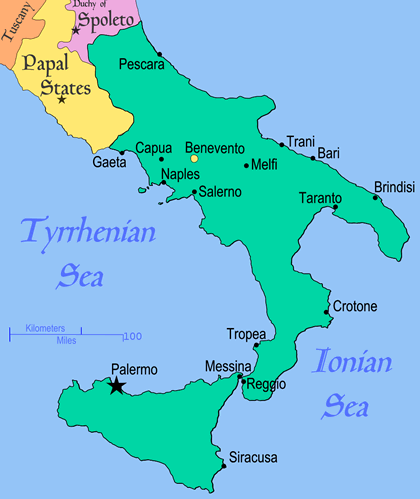 |
| Norman Kingdoms of Italy and Sicily |
Described by some sources as bloodthirsty brigands, the first Norman warriors arrived in Italy from Normandy, France, in search of adventure, land, and wealth.
As foreigners to the fragmented lands of Lombard, Italy, and Sicily, the first Normans were able to take advantage of disputes between the pope, the Byzantine Empire, the Lombard lords, and the Muslims of Sicily to forge a united kingdom out of fractious, petty states.
The Normans assured stability with a strong bureaucracy based on Arab, Greek, and Latin models. The largely tolerant and synergetic culture of Norman Sicily was embodied in the fusion of Arab, Berber, Greek, and western traditions in their architecture, art, and literature.
  |
The Normans epitomized Mediterranean culture and trade, knitting a kingdom that, as the Mediterranean itself, connected Africa, Europe, and the East. At its height the civilization of Norman Italy and Sicily was a remarkable combination of Greek, Arab, and Latin cultures.
Robert Guiscard and his brother Roger I were two of the first Norman warriors to attack Byzantine possessions in southern Italy. They even captured Pope Leo IX in 1053. He was not released from captivity until he recognized the authority and legitimacy of the Normans.
The papacy and the Normans were reconciled after Pope Nicholas II gave Guiscard authority over Apulia, Calabria, and Sicily even as these regions were still occupied by Byzantium and the Muslims of Sicily.
Ibn al Thumma, an Arab from Sicily, offered the entire island to Roger I if he agreed to help establish stability on the island. By 1072 the Normans had conquered Palermo. Despite their thirst for booty, the Normans guaranteed the protection of religion and local laws.
In 1091 Roger I had effectively conquered the entire island, respecting the local laws and beliefs as promised. His feudal system simply copied the Muslim military districts, Muslims were a large part of his army, and Muslim eunuchs took over many bureaucratic tasks.
Roger II, son of Roger I, was probably the most famous Norman ruler. His reign of more than four decades (1111–54) saw the birth of a great trading empire. Recognizing the importance of North African trade, he conquered several cities on the coastline of modern-day Tunisia and challenged the naval supremacy of the North African, Muslim states in the Mediterranean.
 |
| Roger I conquered Palermo |
This opened the rich African gold and Oriental spice market to European traders, creating an economic boon for the Normans, the new masters of the Mediterranean. As a statesman Roger II reformed the judicial system and maintained order among the different religious and ethnic communities of the region.
In addition to Greek scholars and ministers, his court included a harem, and a cohort of Muslim slaves, eunuchs, and administrators. Some Muslim scholars were so impressed by his tolerance and kindness that they claimed he was a Muslim in disguise.
The Palatine Chapel in Palermo, considered the finest example of Norman medieval architecture, exemplified the Norman use of the best Byzantine mosaics, Arab plaster decoration, and Latin painting, creating a magnificent jewel of medieval and intercultural unity even as the rest of Europe was rocked by war and conflict.
   |
Greek, Latin, and Arabic were all official languages of the Norman court. A cadre of religious scholars and poets from the Fatimid dynasty in Egypt, Byzantium, North Africa, Italy, and Spain engaged in free and open debates about the nature of God, faith, and fate, answering difficult theological questions asked by Roger II.
Al-Idrisi, the Arab Sicilian geographer, called his carefully constructed map and description of the world the Book of Roger. A book used by European explorers, the Book of Roger drastically increased western and Latin knowledge of world geography.
Faced with the reconquest of North Africa by the Almohads and other threats to his power, Roger II gradually became less tolerant to the Muslims of Sicily. Norman power began to wane under William, Roger’s successor. He did not have the same energy for statecraft as his father.
Even as the first stage of Norman rule went into decline, a new leader soon emerged from a marriage between a Sicilian and the ruler of Germany, a leader who would bring Sicily and Italy back into an age of cultural brilliance.
 |
| Norman Pallace nowdays |
Frederick II (1194–1250) ushered in the next great era of southern Italian history. As son of Constance of Sicily, he had Norman blood. He was also son of Henry IV, a German king and Roman emperor. As the Normans before him, he had a difficult relationship with the church.
Despite his strong crusading spirit, he was excommunicated by a papacy concerned about the unification of Italy and threats to the Papal States. He was crowned emperor of Jerusalem in 1229, establishing a state that was largely tolerant of different religious faiths.
Inspired by the multireligious culture of Sicily, he created a rare and brilliant era of peace in Jerusalem. Like his Norman predecessors Frederick was very much a man of the Mediterranean.
Far from a provincial German ruler, or a Norman barbarian, he was steeped in the international cultures of Islam, Judaism, and the Greek church as well as the Roman church. It could easily be argued that the cultural patronage and openness of the Norman kings and their defiance of papal authority helped build the foundations of the Italian Renaissance and the birth of humanism.